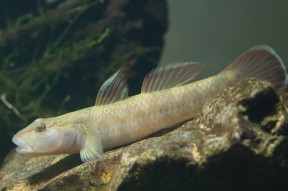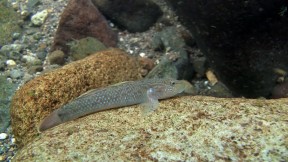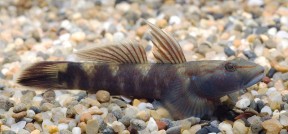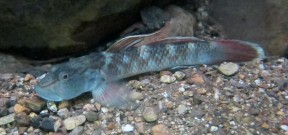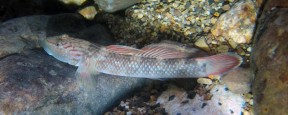Rhinogobius sp. 'CO'
Etymology
Rhinogobius: from the Greek rhinos, meaning ‘nose’, and the generic name Gobius.
Classification
Order: Perciformes Family: Gobiidae
Distribution
The full exctent of its range is unclear but certainly occurs on the island of Honshu, Japan.
Habitat
Inhabits smaller tributaries and streams with substrates of gravel, rocks, boulders, and exposed bedrock which undergo seasonal variations in water flow rate, depth and turbidity.
Some populations are found in brackish and others freshwater environments and this has caused them to adopt different reproductive strategies (see ‘Reproduction’ for further information).
Reproduction
Some wild populations have evolved a complex amphidromous breeding strategy in which adults live and spawn in freshwater or brackish streams and the pelagic post-hatch larvae are washed downstream to the sea where the post-larval fry spend the first part of their life developing in estuarine nursery zones under brackish to full marine conditions.
Once they reach a certain stage of development they begin to migrate upstream with some moving into freshwater tributaries and others remaining in lower, tidally-influenced habitats.
Other populations are land-locked with the entire life cycle occurring in freshwater, and these tend to produce larger eggs than the amphidromous forms.
In nature the fish are reproductively active from summer to early autumn and during this period males begin to defend territories which tend to be centred around a flattish rock or stone beneath which the eggs are deposited.
Post-spawning the female is ejected and the male assumes responsibility for brood care and guarding.
NotesTop ↑
This unidentified species is a member of the R. brunneus complex of closely-related species within the genus Rhinogobius.
Members share the following combination of characters: predorsal naked, or with small cycloid scales, the scaled area never extending beyond the vertical of the posterior margin of the preoperculum; cheek with 2 mainly horizontal rows of sensory papillae.
There are a number of unidentified species within the grouping of which several are referred to using a two-letter code based some diagnostic character of their respective colour pattern, with ‘CO’ shorthand for ‘cobalt’ in reference to the blue spots on the head and body.
R. sp. ‘CO’ has not yet entered the international aquarium trade as far as we know.
References
- Chen, I-S. and K.-T. Shao, 1996 - Zoological Studies 35(3): 200-214
A taxonomic review of the gobiid fish genus Rhinogobius Gill, 1859, from Taiwan, with description of three new species. - Sakai, H., T. Arai, C. Imai, H. Sugiyama, H. Sato and S-R. Jeon, 2004 - Japanese Journal of Ichthyology 51(2): 175-180
Landlocked populations of an amphidromous goby, Rhinogobius sp. CO. - Tsungawa, T. and T. Arai, 2008 - Journal of Fish Biology 73: 2421-2433
Flexible migration of Japanese freshwater gobies Rhinogobius spp. as revealed by otolith Sr:Ca ratios.

